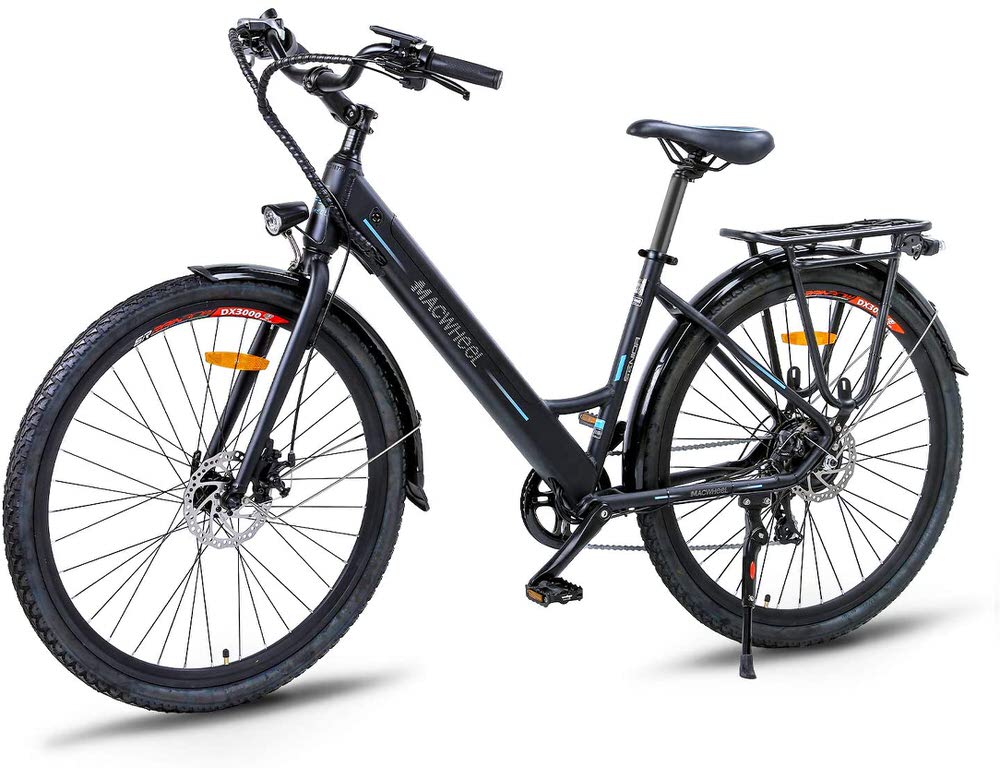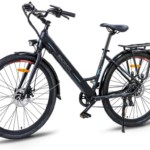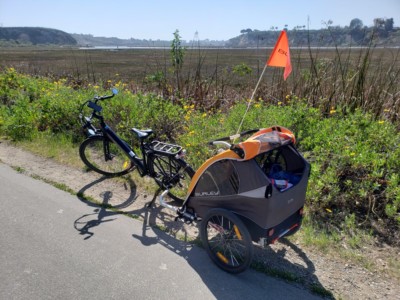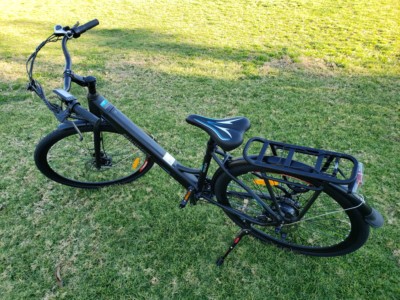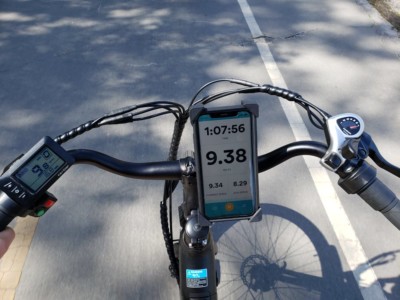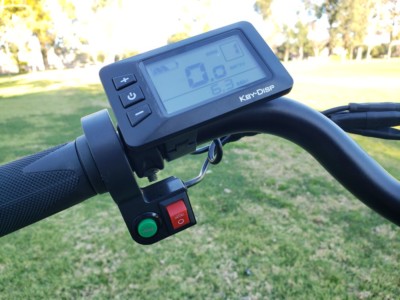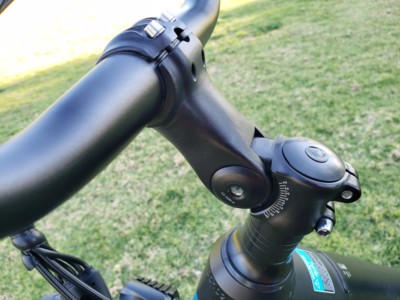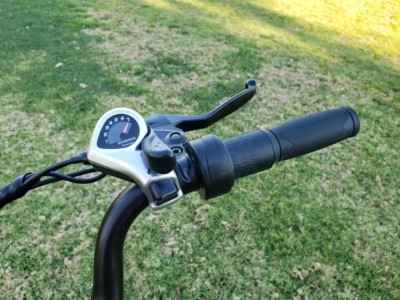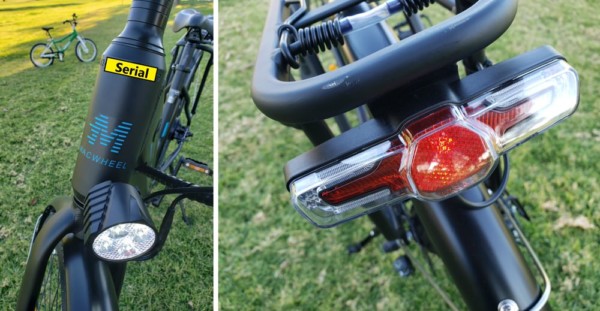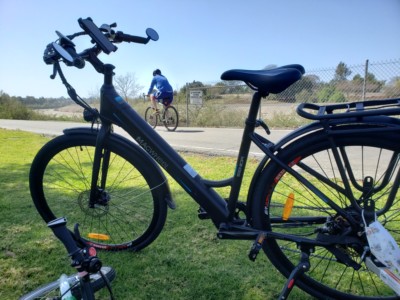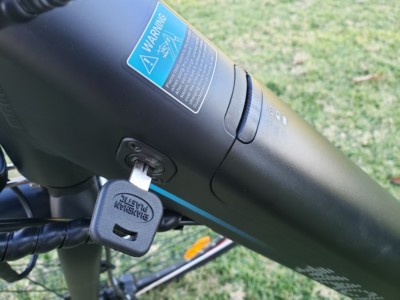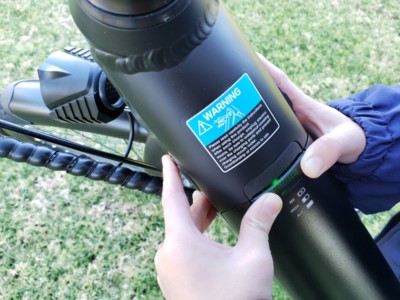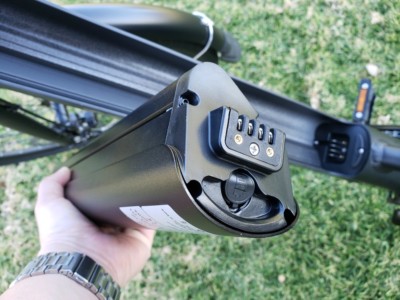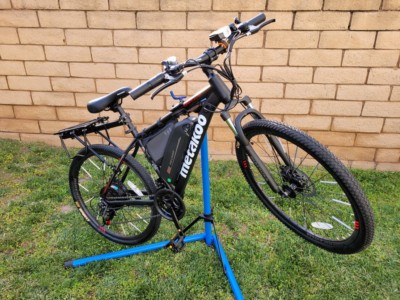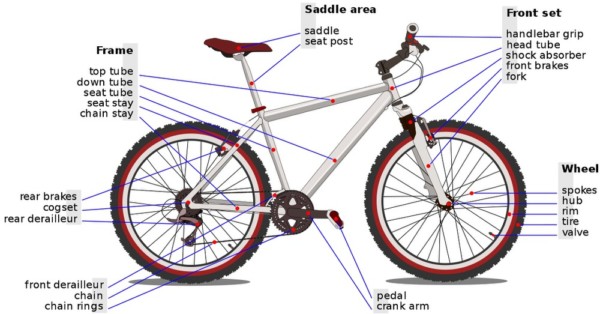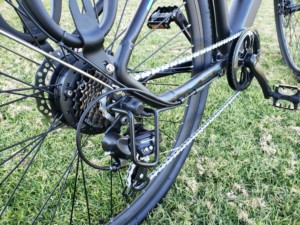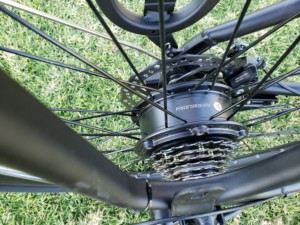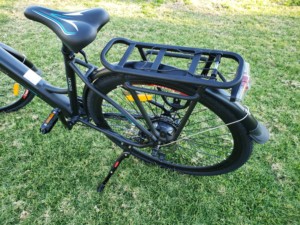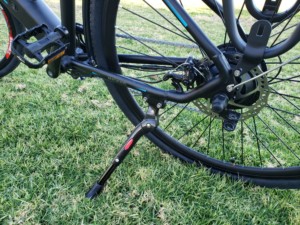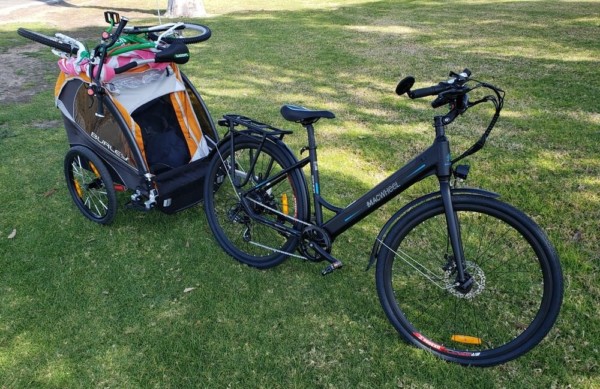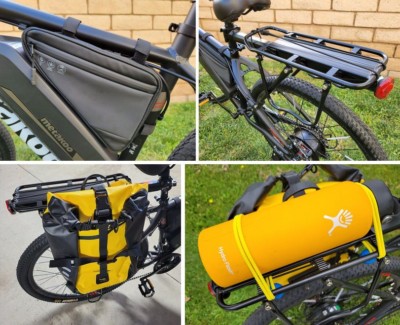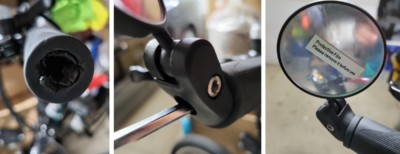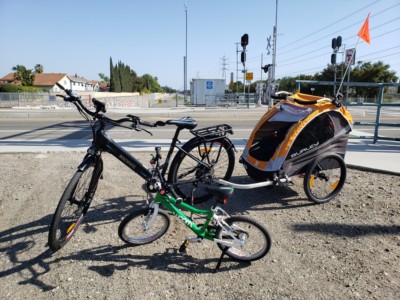Macwheel Ranger 500 Electric Commuter City Bike (26", 7-Speed)
Pros
- Smooth, fast, silent acceleration
- Detachable, long-range 360Wh battery with lock
- Decent 350W motor with 5-level PAS
- Shimano, 7-speed gears
- Very comfortable ride
Cons
- Very heavy at 66 lbs
- Speed limited to 15.5 mph
- Slow charging at 48W
- Thick down tube limits accessory options
- Some may not like the down-tube look
Contents
Cruising With Ease
My brother purchased the Macwheel Ranger 500 electric bike last year for Christmas, and of course I wanted to see how it would fare against the one I got for my mother-in-law, the semi-foldable Gyroor C3. I liked his’ a LOT more. However, the city cruiser look was not for me, and I ended up getting a mountain bike from Macwheel’s sister company, Metakoo, for myself instead: the Cybertrack 100 eBike. I was not going to review the Ranger 500, but several readers emailed me to write one up, and so here it is based off notes and photos I took when my brother and I assembled it.
Bike or Scooter?
Electric scooters are more nimble to move around with — and in some cases, more fun — but local laws may prevent them from going onto the same paths as electric bicycles. Most can also be carried around more easily due to their more compact size and lighter weight. Personally, I prefer bikes because they are safer to operate, can (usually) go onto the same places that mechanical bicycles can operate, are (generally) allowed to carry an additional passenger, and if the battery runs out or fails, you can still pedal around. A scooter would stop to function without a battery.
In A Nutshell
The Macwheel Ranger 500‘s packaging stood out the moment its shipping box was opened: there was an almost obsessive amount of protection applied to all parts, including metal braces to protect the rear derailleur and front fork. I had rarely seen that level of safeguarding with a non-US/EU branded bicycle before. First impression of this bike and the company started off good.
Assembly was very easy: attached the front wheel, front fender, handlebar, pedals, kickstand, and front headlight, and adjusted cables as needed (YouTube video available). No major tuning was needed, in fact, including the brake and gear shift cables and Tektro disc brakes. My brother and I were prepared to make some adjustments to the front disc brake module, but surprisingly, it was working with no friction right out of the box. The bike came with 26″ tires, an 18″ aluminum frame, and KMC Z51 chains that were already lubed. After we adjusted the seat post height (which should accommodate someone between 5’4″ – 6’4″), handlebar angle, and charged the battery for 3-4 hours, we took it out for a spin.
The LCD control panel showed the units in “km/h“, but thankfully, one of the manuals provided instructions on how to change it to “mph“. The battery level could be seen on both the display (20% increments) and through the push of a button on the battery itself (LED bars in one of three colors). You could control the motor’s assistance amount through the push of the “+” and “-” buttons on the LCD unit: from being entirely off to as high as 5 levels of power, including Pedal Assist (PAS). The current speed, other trip information, and odometer reading were also available.
The Pedal Assist System (PAS) is useful for when you want to pedal with a small amount of electronic help. The less the motor is engaged, the greater range and battery life (and exercise) you will have during the ride.
Battery is removable and can be locked with a provided pair of keys, allowing the bike to be secured outside while bringing the 360Wh battery (36V @ 10A) into the office or home for desk side charging. It took about 6-8 hours to fully charge.
A 350W motor was not the most powerful, but gave a silent, satisfying push up hills with a 195 lb rider and additional 30 lb bike carrier. The manufacturer claims a 37-50 mi range with pedal assist and 19-25 mi when in full electric mode. On a test ride, only 20% of battery was used for a 23 mile route where PAS was only activated for the uphill sections. The bike’s maximum speed was capped at 15.5 mph, whereas the Metakoo Cybertrack 100 and Googo SY26 could go as fast as 20 mph despite sharing similar motor specifications. US law, in general, allowed for up to 20 mph.
True to the bicycle being sold as a commute cruiser, I was pleased to see a rear luggage carrier pre-installed that was strong enough for a second passenger to sit on. Whether that is legal for another person to ride on is unclear, but that was a common sight when I grew up in Europe. Fenders on both ends protected riders from water and mud. Control panel-activated front and rear lights were bright, tail light illuminated with braking, and the electronic horn was sufficiently loud to gain the attention of other bikers and pedestrians.
Gear shifting worked as well as anything Shimano makes. With just 7 gears, do not expect to climb the most challenging trails with it, but it works perfectly for urban riding. Why would gears matter with an eBike? What if the battery ran out? Pedaling a 66 lb bike up inclines without motor assistance or the ability to shift gears can be an extremely challenging situation, and thus, the variable speeds are a nice peace of mind to have. Rides were smooth with the lockable, front fork suspension.
Overall, the Macwheel Ranger 500 was a full-featured eBike with a design targeted at individuals and families cruising around the city and urban areas. The pre-installed, rear bike rack allowed for carrying groceries and other gear (including a rear rack seat cushion) with an optional pannier, and getting on and off the bike was easy with its downward-sloping top tube. Some associate that frame design to be for women, but that is no longer the case today. Fun and ease came to mind while riding, but personally, I preferred the mountain bike look (with less comfort) of the Metakoo.
What’s Good? What’s Bad?
Pros
- Smooth, fast, silent acceleration with brushless motor
- Nominal (average) power: 350W. Rated (maximum) power: Unknown
- Top speed: 15 mph, tested (California speed limit is 20 mph)
- 44 nm torque (Metakoo Cybertrack is 50 newton-meters)
- (4) Power modes
- Fully electric: No pedaling necessary
- PAS – Pedal Assist System: Get assistance while pedaling
- Motor off: Move bike with the power of your own legs ;-)
- On demand: Turn handlebar throttle to manually increase speed and motor assist level
- Battery: 360Wh Li-Ion (36V @ 10Ah, 18650 cells)
- Detachable with Lock and 2 keys for more convenient charging
- These types of batteries have a 500+ cycle lifespan and lose about 20-25% capacity after every 500 cycle
- Metakoo’s is 374.4Wh for minimally longer range
- Bikable in rain but do NOT go through water that is high enough to reach the motor or battery!
- 48W wall charger (2A @ 42V)
- Charges battery in 6-8 hours
- Metakoo’s 168W allows itself to fast-charge in just 3 hours
- Range: 19-25 mi on fully-electric, 37-50 mi on pedal assist modes (according to manufacturer)
- Estimate is in line with other 350W eBikes that have a 360 Wh battery, though the range is slightly less than the Metakoo
- Approx. 90-110 mi with occasional pedal assist based on a 23 mi ride with motorized help on uphill climbs (while towing 195 lb rider, 50 lbs cargo, and 66 lb bike itself)
- Shimano 7 speeds (Tourney RD-TY300D) at rear with SL-TX50-7R shifter and KMC Z51 chains
- When the battery is out, the higher number of gears will allow easier, more effective, manual pedaling
- Dual, mechanical, Tektro disc brakes for faster, more controlled stopping
- Front shock suspension for smoother, comfortable handling, although there is no rear shock absorber
- Programmable LCD Control Panel
- Displays speed (km/h by default) / battery and motor output levels (20% increments) / motor assistance amount (0-5) / odometer / trip time / trip distance / average speed / max speed
- When motor assistance level is set to 0, motor does not turn on, and you will pedal fully manual
- Backlit with 3 brightness levels and was readable in bright daylight even at the lowest setting
- Displays speed (km/h by default) / battery and motor output levels (20% increments) / motor assistance amount (0-5) / odometer / trip time / trip distance / average speed / max speed
Serial number is etched onto the front fork at the bottom of the frame’s neck for registration with local police to aid with recovery
- Arrived nearly fully assembled
- Took 17 mins to finish build
- Rotate threadless stem, adjust its height, attach handlebar, pedals, front wheel, front fender, seat post, headlight, and make small, tuning adjustments
- Took 17 mins to finish build
- 18″ aluminum alloy frame with rider support for up to 250 lbs, according to Macwheel
- Can accommodate 5’4″ – 6’4″ biker height with its quick-release seat post
- Step-through frame (downward-sloping top tube) allows rider to more easily mount/dismount
- This design used to be associated with women bikes at a time when females used to primarily wear long dresses, but that is no longer the case today. As such, both men and women can now be seen with this type of frame design
- 26″ Tires (28 x 1.75 tube) for more controlled, comfortable rides
- Uses Schrader valve with recommended pressure of 40-65 psi
- Battery-powered head and tail lights (activates with brakes)
- Rear rack for carrying cargo
- Consider adding a rear rack seat cushion
- Weight: 66 lbs (quite heavy!)
- Built-in kickstand
- Well-written, illustrated manual
- Tools included
- 1 year warranty
Cons
- Heavy at 66 lbs (Metakoo Cybertrack 100 is only 46 lbs)
- Thick down tube limited available options for mounting front bike bags and child seats
- Limited options to mount items onto the frame, such as a water bottle cage or tire pump
- Default unit display was kilometers (km/h)
- Can be changed to miles/mph. See PROGRAMMING section
- Slow charger at 48W, taking 6-8 hours for battery to go from empty to full
- Some assembly required (though very minimal)
- Those not well-versed with bike building may struggle a bit, especially if some tuning needs to be performed. A YouTube video shows the major steps
- Not built for rough terrain (it is not a mountain bike)
- Rear does not have shock suspension
Tips
Maintenance
- Before first use, charge the battery fully
- Covered charging port is on the removable battery itself
- AC charging brick LED: Red = Charging. Green = Full
- Lithium Ion batteries are known to be volatile and could catch on fire
- Do not charge overnight or unsupervised for prolonged periods of time. Stop charging once full
- Do not leave the bike in full sun or below freezing
- Keep battery charged at 50% or more to prolong battery’s 500+ cycle lifespan. Try to never let it drain completely
- Lithium-Ion batteries lose about 20-25% of capacity after every 500 charging cycle
- Before riding, check the tire pressure (40-65 psi) and tighten any loose screws
- Ensure seat post AND handlebar/stem are locked and tight
Operations
- Motor: Enable it by pressing the “Power” button on the display unit
- Pedal the bike, and you will feel the motor assisting (Pedal assist)
- Throttle the accelerator by the right-side handle, and the motor will fully take over (Power on demand)
- The more you turn, the faster the bike will go
- To power off the motor so you would only be able to pedal manually, press Power (Pedal only) or set Assist Level to 0 on the display
- Manual power assist: Press and hold “-” button for 2 secs to activate motor at low speed
- Helps with walking the bike uphill
- As battery neared empty, I noticed that maximum speed gradually lowered
- Do not brake hard. Doing so could make you painfully tumble, skid, and/or wear out the tires
- Be aware of unexpected obstacles. I tumbled once while mountain biking and was hurt quite badly. It was not fun
Aircraft Transport
Most, if not all, airlines prohibit electronic scooters and bikes that do not meet specific criteria. United Airlines, for example, allows collapsible ones whose battery is both removable and below 300 Wh. Southwest Airlines is more restrictive at 160 Wh. This bike’s is battery 360 Wh. Lithium-ion batteries are known to be volatile, and the higher their capacity, the more risky they are. Check with the airlines, TSA, and FAA for more details.
Bike Assembly
Here are some installation tips for those assembling their first bicycle. First, look at the below diagram to identify the major bike parts, then watch the Macwheel-made YouTube video found right after.
Bike Repair Stands
I use a repair stand to help with assembly and maintenance. SereneLife SLBKRS3 has a maximum load capacity of 66.7 lbs — enough to carry most electric bikes without falling over.
For easier maintenance or assembly, a bike repair stand can save a lot of time and back pain. Be sure to get one that can hold up your bicycle’s weight.
Bike Parts
Installation Video
Installation Tips
- There is an arrow on the side of the front wheel. Make sure it points forward and in the same direction as the back wheel
- Once you attach the handlebar to the height-adjustable stem, be sure both are securely tightened
- On my first ride, the stem was not tight enough and it gave in a bit. Thankfully, I was not going fast or I could have lost my balance
- When placing the Quick Release skewer through front wheel, there is a spring on each end. The narrow part should face inward toward the bike
Programming Bike
The LCD displayed the current speed and odometer in kilometers and km/h by default. I found the manual for a similar-looking LCD controller (KD21C – PDF) with VAST instructions that corresponded with this Macwheel, but I did not test each option nor included everything here. It should be noted that changing any settings could void the warranty and cause unintended consequences such as injury.
To enter programming mode: Hold the “+” and “-” buttons together for 2 seconds to enter General Settings. Cycle through the options by pushing Power.
Program Options
Here are the various options that can be set.
PROGRAM AT YOUR OWN RISK!
General Settings
- tC: Clear trip distance. Yes, No. Default: No
- bL: Backlight brightness level. 1, 2, 3. Default: 1
- U: Unit display. 2 = kilometers (km/h), 1 = miles (mph). Default: 2
Advanced Settings
Hold “+” and “-” again on the General Settings screen to enter Advanced Settings.
- VOL: Voltage for each battery power bar level. Defaults: 1 = 31.5 / 2 = 34.5 / 3 = 35.6 / 4 = 37.4 / 5 = 39.2
- There are 5 LED bars to indicate remaining battery level at 20% increments. As voltage drops to the configured setting, the respective LED bar would show
- Example: Battery voltage between 34.5V – 35.5V = 2 bars (40% battery left)
- SCA: Power Assist Ratio. The amount of motor assistance to provide at each PAS level. By default, there are 6 levels (0-5) with 0 referring to no assist
- Defaults: Item “0-5 (1-5)”. Level 1 “5-1” Default: 50% / “5-2” Default: 61% / “5-3” Default: 73% / “5-4” Default: 85% / “5-5” Default: 96%
- CUr: Controller Overcurrent Cut. Default: 22.0
- PAS: Power Assist Sensor. Forward, Backward direction. Default: run-F
- SPS: Speed Sensor. 1-15. Default: 1
- Hnd: (Handlebar?) Throttle Push Assistance (unsure what this does). Yes, No. Default: No
- SYS: System. “Delay time of battery power” (unsure what this does). 3, 6, 12 secs. Default: 3
- Push “Power” button on this screen for additional options
- LS: Max speed limit. 25 – 40 km/h (15.5 – 24.8 mph). Default: 40 km/h
- Curiously, bike can only go up to 15.5 mph despite the setting being 24.8 mph
- PUS: Button Push Assist Enable. Yes, No. Default: Yes
- This may correspond to the manual power assist when you hold the “-” button for at least 2 secs. I use this to help push the bike uphill while walking
- PUS: Button Push Assist Speed. 20% – 35%. Default: 25%
- SSP: Slow Start. 1-4 secs. Default: 1
- This may refer to how long to wait after pedaling for power assist to kick in
- LS: Max speed limit. 25 – 40 km/h (15.5 – 24.8 mph). Default: 40 km/h
- Push “Power” button on this screen for additional options
- PSd: Power-on Password. To protect controller’s settings from getting changed
Error Codes
If an error occurs, one of the following codes will display on the LCD:
- 21: Current abnormality and generally a controller issue due to motor being too high-powered or current too high. A new controller may be needed
- 22: Connection error between throttle sensors and main controller. Cable may be loose or magnets inside throttle became dislodged
- 23: Connection error between rear hub motor and controller. Cable may be loose or damaged
- 24: Sensor within rear hub motor failed. Cable between motor and controller may be loose or damaged. Motor may be damaged
- 25: Brake sensor connection error. Brakes will still manually work but will not be in sync with the speedometer and LCD screen. Error may have been caused by the brakes having been activated while turning on the LCD. Do not touch the brakes when powering up the screen
- 30: Connection error between LCD screen and controller. Cable may be loose or damaged
Motor Bike Laws
I first learned about laws governing motorized scooters when reviewing the Joyor X5S, and unfortunately, they were (and still are) not straight-forward. There had been a number of accidents involving scooters hitting pedestrians or riders hurting themselves. I get it. Laws are there to protect people from each other and themselves, especially from irresponsible individuals.
Electric bikes can result in severe injuries or death with their high speeds.
Surprisingly, the laws governing electric BIKES are much more lax. They are very similar to non-motorized bikes, in fact! There are different classes of eBikes. This Macwheel falls under the lower-speed Class 2 with a maximum of up to 20 mph, and as such, can be used on Class 1 bike paths in California. All 3 classes can ride on the protected, one-way Class 2 bike lanes found on streets and highways. Be sure to check with your local regulations. Some States categorize eBikes as mopeds or motor vehicles.
- Class 1: PAS-only with no throttle. Max assisted speed: 20 mph
- Class 2: PAS and throttle. Max assisted speed: 20 mph
- Class 3: PAS-only with no throttle. Max assisted speed: 28 mph
California Law
Disclaimer: I AM NOT A LAWYER. Please consult your local city, police department, and/or legal professional for advice.
The following is my interpretation of how I understand the law. It has been shortened to only point out parts that I found interesting or noteworthy.
- Does NOT require riding with a Driver’s License or Instruction Permit (eScooters require them!)
- No license plate required
- Passengers are allowed as long as the bike was designed for it
- Can ride on existing bike infrastructure
- Speed limited to 20 mph
- Follow most of the same laws as non-motorized bicycles
- Helmet required for riders 17 years and younger
- No minimum age limit
Accessories
Some accessories I recommend for this bike for added convenience and safety:
- Rhinowalk Pannier Cargo Bag: A 27L, waterproof, very visible bike, laptop, and shoulder bag for a bike rack
- Ball Bungees: To fasten cargo more securely to the rack, such as my favorite Hydro Flask water bottles that can hold ice for days
- Salzmann 3M Spoke Reflectors: For increased visibility in the dark
- Bar End Bike Mirrors (like BriskMore, Tagvo, or Zacro): To see behind you
- Rear rack seat cushions
- Kootu Folding Pedals: To take up less storage space and not get snagged on things
- Burley Trailer Coupler: So trailer can be switched to another bike (ie. bike failed or ran out of battery)
Final Thoughts
My brother and I were quite happy to see the Macwheel Ranger 500 already (mostly) preassembled and properly tuned right out of the box. The 350W motor gave great assistance while pedaling around the city trails, but for some reason, its maximum speed was only 15.5 mph when the Metakoo Cybertrack 100 and Googo SY26 (both also 350W) could go 20 mph. It was, however, a better eBike with 7 gears than the single speed Gyroor C3 because if the battery ran out, having additional gears would tremendously help with navigating inclines with more ease.
The ability to remove the lockable 360Wh battery conveniently allowed it to be charged without having to bring the entire bike to the AC outlet. It also provided the option to replace a depleted battery for as long as Macwheel made replacements available.
Biking is both a healthy activity and a great way to bond with one another, and having an electric bike for family trips has become a MUST for me to help stave off leg cramps while towing my children, one of their bikes, and snacks in a bike carrier.
Do I recommend the Macwheel Ranger 500? Yes. It has good range, swift acceleration, comfort, and commute-friendly features (ie. rear rack, battery-powered lights). I can see why my brother and his wife like it. But, if you are someone like me who is used to riding a Santa Cruz Heckler or prefer the mountain bike look, then either the Metakoo Cybertrack 100 or Googo SY26 are the ones I recommend.
Where To Buy
- Macwheel Ranger 500 Electric Bike
- Accessories
- Kootu Folding Pedals | Ball Bungee Cords | Rhinowalk Pannier Cargo Bag
- Salzmann 3M Spoke Reflectors
- Bar End Bike Mirrors: BriskMore, Tagvo, Zacro
- Rear rack seat cushions
- Hydro Flask Insulated Water Bottles
- Burley D’Lite 2-Seat Bike Trailer/Stroller
- Additional Trailer Coupler so Burley can be switched to another bike (ie. bike failed or ran out of battery)
Related Posts
- Reviews
- HeyBike Cityrun: Beautiful, 26″ electric cruiser bike with 500W motor, 7 speeds (21mph)
- Polarna M4: 20″ foldable, electric bike with 750W motor, 8 speeds (30mph+), and 4″ fat tires
- Jasion EB7: 20″ foldable electric bike with 3″ fat tires, 7 speeds, and can accommodate 5’1″ – 6’2″ tall riders
- Googo SY26: 26″ electric mountain bike with 21 speeds, large informative LCD, electronic headlight and horn, and solid build
- Metakoo Cybertrack 100: 26″ electric mountain bike with 21 speeds and a clean look
- Ancheer AM001907/AN-EB001: 26″ electric mountain bike with 21 speeds, electronic headlight and horn, and powerful, rapid acceleration
- Gyroor C3: Single speed, electric, semi-foldable, and priced fairly low
- How to Quickly Teach a Child to Ride a Bike (Balance With No Training Wheels)
- Bike USA Stabilizer Wheels for Adult Bicycles

